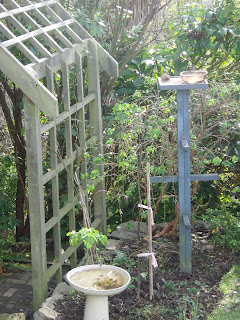Since I was a child I have been fascinated by birds, yet there were never many birds in the garden at the house I grew up in. We had cats and a dog that would always manage to scare them off. However since moving to my home in Mornington, Dunedin I have been able to enjoy the vast amount of birdlife that New Zealand has to offer. My house is situated within 1 kilometer of the town belt, a strip of land that is protected by the council and provides a safe haven for birds including the Kereru, Tui and Bellbird. This means that I am lucky enough to have regular native visitors.
My partner (who wanted me to add a pic of himself being silly) kindly made me a bird table and in winter when I put sugar water out I encourage large flocks of birds into the garden, I find that I am having to put a litre of sugar water out everyday.
shake your tail feather
beaut bird bath
thomas
There is sometimes upwards of 30 silvereyes in my cherry and pseudopanax trees and I can almost always hear the beautiful bellbirds song. I do however have to be careful when putting out seeds for the birds. They are so messy, they scatter the seeds from one end of the garden to the other so I am always finding little grass and grain seedlings popping up here and there.
It seems as though there are many people around New Zealand that are just as keen on birds as I am. More than 2000 surveys for the 2011 Garden Bird Survey by Landcare Research have been completed recording the presence of 125 unique species of bird and the preliminary results from 1445 of these surveys have been published on their website. The long-term aim of the survey is to determine trends in bird numbers over time.
Interesting stats about the number of silvereyes visiting gardens this year have emerged from the survey. From 1445 survey returns processed to date, the average number of silvereyes was less than half the number counted last year (6.5 compared with 13.2 per garden). Survey participants made comments such as, ‘Where are all the silvereyes?’ and ‘The lowest number of silvereyes we’ve had in years’.
The website puts the decrease in silvereye visits down to the mild winter the country has experienced this year. "The lack of snow and frosts may mean there is still plenty of natural food around, so birds have not been forced into gardens in search of food".
The website also noted that 'there are some spurious results such as piopio, which will be deleted when the data are edited". Curious considering that the piopio Turnagra capensis, also known as the New Zealand Thrush, is now extinct.




No comments:
Post a Comment